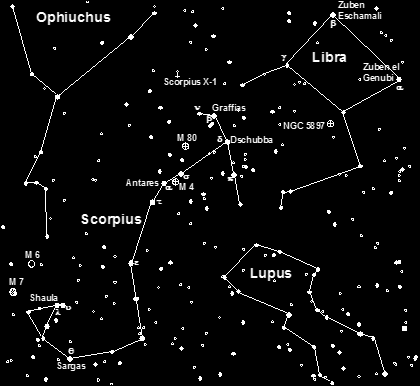Scorpius and Libra
Antares is the brightest star in Scorpius. Its name, meaning “Rival of Mars” refers to its colour. It is a red supergiant. The Hipparcos satellite recalibrated its distance to just over 600 light years, further than previously thought. As a result Antares (rather than Betelgeuse) is now known to be the largest first magnitude star. Antares is also a double star, but the glare of the bright primary makes it a considerable challenge for amateur telescopes.
Nu Scorpii for example is a quadruple star, similar to the well known “Double Double”, Epsilon Lyrae. Two of the components are however separated by little more than an arcsecond (tight!).
Delta Scorpii (Dschubba) is normally at magnitude 2.3, but in 2000 suddenly flared up to attain a magnitude of 1.6. Since then its brightness has fluctuated considerably. Currently it has dropped back to about 2.0, its faintest since the initial outburst.
Scorpius boasts two fine globular clusters, M4 and M80. Both are easy to locate near to Antares, but their low altitude means that they are never seen at their best from the UK.
Scorpius also boasts two of the best open clusters in the sky in M6 (The “Butterfly” Cluster) and
M7 (Ptolemy’s Cluster). These are both unfortunately severe challenges for UK observers, with M7 being the most southerly object in Messier’s catalogue. Paul Money however reports being able to see them from as far north as Lincolnshire.
Scorpius X-1 visually is only a 13th magnitude star. It is however one of the strongest sources of X-rays in the sky. It is thought to be an exotic binary system in which one component (probably a neutron star or black hole) is accreting material from the other.
In ancient times the stars of Libra and Scorpius were considered to be one constellation and the names of the two brightest stars in Libra reflect this, meaning “Northern Claw” and “Southern Claw”.
Zuben Eschamali (Northern Claw) is an interesting star. It was considered once to be of first magnitude and so may be a genuine case of a star that has faded over the past few thousand years. It is also said to be the only bright star that shines with a green hue. Libra also possesses one fairly modest globular cluster in NGC 5897.
POWERPOINT SLIDE SHOW (306KB)